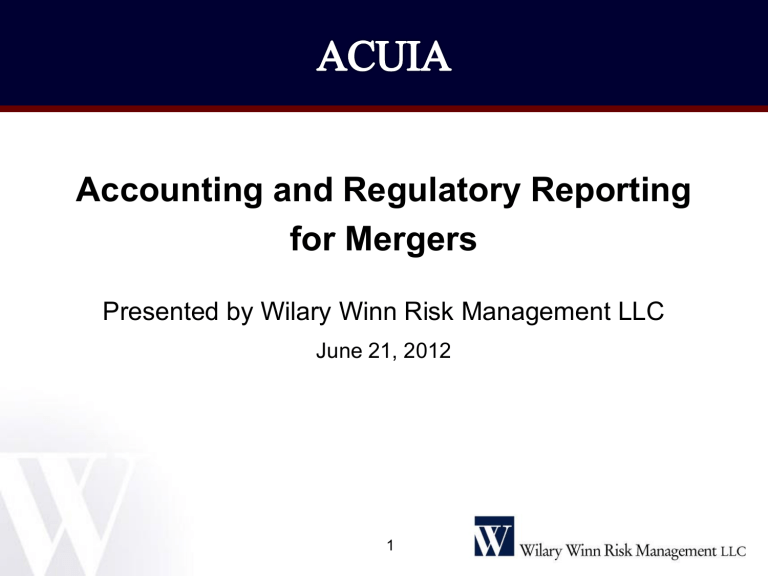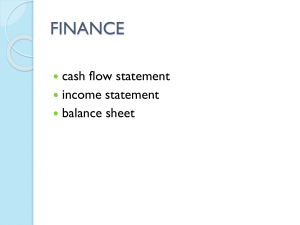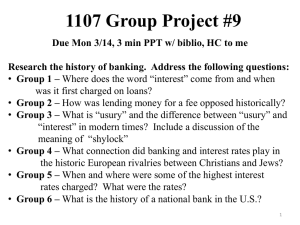Day 2 Accounting for Loans

Accounting and Regulatory Reporting for Mergers
Presented by Wilary Winn Risk Management LLC
June 21, 2012
1
Topics for the Session
• How to Record Transaction on “Day 1”
• “Day 2 Accounting” and ongoing requirements
2
New Accounting for
Business Combinations
• A combination of mutual entities, including credit unions, is treated as a “purchase” and must be accounted for under FASB ASC Topic 805 – Business Combinations
(FAS 141R)
• The fair value of the credit union to be merged in and its assets and liabilities must be accounted for at fair value in accordance with FAS ASC 820 – Fair Value
Measurements and Disclosures
3
Value of Acquired Credit Union is a
Two Step Process
• Step 1 – Value the entity as whole – the result is accounted for as a direct addition to equity
• Step 2 – Determine the fair value of the acquired credit union’s assets and liabilities
4
Value of the Entity as a Whole
• Rules regarding valuing a business are set forth in the
Statement of Standards for Valuation Services of the
American Institute of Certified Public Accountants
• Experts generally use income-based and market-based approaches to determine fair value
• Values derived using the different methods must be reconciled to reach an overall fair value conclusion
• Entity value of credit union acquired in a bid transaction is the purchase price
5
Income-Based Approaches
• Estimated future cash flows are discounted to derive an estimate of fair value
• Generally involves the use of a CAPM pricing model using an after-tax discount rate
• Estimate of terminal value is generally included – Gordon
Growth model
6
Further Considerations of
Income-Based Approach
• Most experts use income versus cash flow to value financial institutions
• Need to adjust for the amount of income that must be retained in order to remain well capitalized
• A key assumption is the future rate of growth
7
Further Considerations of
Income-Based Approach
• Historical review
• Review of operating market
• Discussion with management on operating issues specific to the credit union
8
Key Metrics for
Income-Based Approach
• Discount rate - Ibbotson Cost of Capital
• Profitability - NIM, non-interest income and expense
• Asset Quality - ALLL
• Liquidity - Loans to Deposits ratio
9
Market-Based Approaches
• Generally involve the price to earnings ratio or price to book value for publicly traded community banks with similar size, asset composition, operating strategies and geography
• Need to adjust for differences in return and growth
• Commercial lending
• Market-based approach is not a sufficient valuation on its own
10
Overall Value
• Need to reconcile income and marketplace valuations
• The result is the equity amount to be recorded on Day 1
• Generally no overall entity value for distressed credit unions
• We often see equity values equal to the fair value of the assets and liabilities – value is equal to liquidation amount
11
Value of Financial
Assets and Liabilities
• The valuation for loans is not as simple as comparing the interest rate on the loan to current market interest rates using an ALM model – the fair value must include the estimated credit losses
• The value derived should be an “exit price” according to
FAS ASC Topic 820
• Because the credit losses are included in the loans’ fair value, the allowance for loan losses is brought over at zero
12
Value of Financial
Assets and Liabilities
Fixed Rate Mortgage
Home Equity
HELOC
New Vehicle - Direct
Used Vehicle - Direct
Motorcycle
RV
Boat
Signature
Share Secured
Consolidation Loan
Student Loan
Total
Principal
Balance
7,500,000
2,500,000
5,600,000
3,400,000
4,500,000
60,000
75,000
250,000
12,500,000
170,000
5,500
350,000
36,910,500
# of Avg Avg Avg Future Discount Fair
Loans FICO LTV* WAC Age WAM Life CPR % CRR % CDR % Severity% Loss % Rate Value %
46
76
133
370
532
12
6
6
2,752
33
4
38
4,008
747
726
743
679
664
711
635
745
655
714
656 n/a
698
68%
71%
68% n/a n/a n/a n/a n/a 6.1% n/a 12.8% n/a 2.5% n/a 13.8% n/a 6.2%
69% 8.1%
5.9%
6.9%
2.9%
6.7%
7.6%
6.5%
9.9%
54
37
26
26
22
18
21
10
27
13
44
3
32
277
161
209
40
33
41
81
101
52
34
16
73
126
4.0
3.7
5.4
1.3
1.4
1.3
2.3
2.4
2.0
1.2
0.5
1.3
2.9
18.0% 13.9%
9.3% 6.2%
15.5% 12.8%
25.3% 18.1%
22.7% 17.9%
18.9% 17.6%
23.7% 16.6%
25.1% 21.0%
17.0% 8.2%
19.7% 19.7%
16.3% 9.0%
14.0% 12.8%
18.0% 12.3%
4.0%
8.8%
0.1%
7.3%
1.2%
5.7%
4.0%
3.2%
2.7%
7.2%
4.8%
1.3%
7.1%
22.2%
61.4%
48.2%
58.8%
53.4%
2.9%
3.8%
4.5%
5.5%
3.3%
35.0% 0.6%
61.1% 10.9%
61.1% 5.8%
100.0% 16.2%
0.0% 0.0%
100.0%
2.5%
68.1%
3.4%
0.0%
8.0%
6.4%
6.8%
5.9%
6.9%
7.6%
9.5%
12.9%
8.5%
15.8%
4.0%
16.2%
8.6%
9.8%
Fair
Value $
96.0%
96.5%
83.5%
95.0%
96.5%
96.0%
85.0%
90.0%
82.0%
98.0%
92.0%
97.0%
89.3%
7,200,000
2,412,500
4,676,000
3,228,300
4,342,500
57,600
63,750
225,000
10,250,000
166,600
5,060
339,500
32,966,810
Credit
Only
Difference Difference
1
Discount
Rate
Difference
2
(300,000)
(87,500)
(924,000)
(171,700)
(157,500)
(2,400)
(11,250)
(25,000)
(2,250,000)
(3,400)
(440)
(10,500)
(3,943,690)
(215,000)
(94,000)
(235,000)
(164,700)
(150,000)
(300)
(6,600)
(11,000)
(1,740,000)
(10)
(200)
(400)
(2,617,210)
(85,000)
6,500
(689,000)
(7,000)
(7,500)
(2,100)
(4,650)
(14,000)
(510,000)
(3,390)
(240)
(10,100)
(1,326,480)
Non-
Contractual Accretable
Cash Flows Cash Flows
11,866,223
3,741,895
7,054,554
3,720,251
5,142,877
62,121
98,585
263,269
16,293,567
173,365
5,690
399,110
48,821,507
2,699,491
552,208
847,341
233,824
294,237
1,519
20,340
39,551
2,895,180
1,001
203
3,953
7,588,848
1 Credit Only Difference is referred to as the Credit Valuation Allowance
2
Discount Rate Difference is referred to as the Discount Rate Valuation Allowance
13
Value of Financial
Assets and Liabilities
• We generally see required adjustments for HTM investments and share certificates
• Prepaid expenses may have to be adjusted down if there is no benefit to an acquirer
– For example, a multi-year prepaid contract for a service that cannot be used after the merger has no “fair value”
• Accrued expenses should not include merger-related costs
14
Value of Financial
Assets and Liabilities
• Need to identify liabilities that have not been recorded that will be triggered indirectly by the merger – some forms of compensation, buy-outs of lease agreements, etc.
• Need to consider whether operating leases are favorable
(asset), unfavorable (liability) or at market
15
Value of Non-Financial
Assets and Liabilities
• The largest non-financial assets are generally land and buildings – we generally have our clients obtain a commercial real estate appraisal(s) if they are material
16
Core Deposits
• Non-maturity shares are recorded at book value
• A core deposit intangible is recorded as an intangible asset
17
Intangible Assets
• The most common intangible assets are the core deposit intangible, mortgage servicing rights and customer relationships
• Trade name – need to consider defensive value as well
• Recognition of an intangible asset requires that the asset be separable or have a contractual or legal benefit
18
Core Deposit Intangible
• Benefit of low cost deposits:
It is not the value of the overall deposit derived by comparing the interest rate on the deposit to rates at the time of the merger.
Instead, it is the estimated value of the deposits based on the fees they generate and the costs to maintain them compared to an alternative source of funding such as the Federal Home Loan Bank or
Wholesale Share Certifcates – SimpliCD.
19
Other “Day 1” Accounting Considerations
• Merger-related expenses must be expensed
• Restructuring costs of acquirer are recorded as “posttransaction” expenses – ‘Compensation’ vs. ‘Consideration’
– Costs that benefit buyer or combined entity are compensation
• Assets that an acquirer does not intend to use should still be valued at their “highest and best use”
– Example: defensive value of a trade name or unused leased space
• The accounting for contingent consideration is complex
20
Goodwill or Bargain Purchase
• The balancing amount to the Day 1 journal entry is goodwill or bargain purchase
• We believe a bargain purchase is a relatively rare event
• Example of bargain purchase:
NCUA-assisted transaction where the value of the net assets received, including the consideration from the
NCUA, is greater than the amount of liabilities assumed
21
Regulatory Reporting
• The equity acquired in the merger (the overall value of the acquired credit union) is not included in the calculation of regulatory capital
• The acquired credit union’s book equity as of the merger date is recorded instead
• In the case of regulatory-assisted transactions – the book value of equity is not recorded and any consideration received is a dollar for dollar reduction of goodwill
22
ASSETS
Cash
Available for Sale Securities
Investments
Total Membership and Paid In Capital
All Other Investments in Corporate Credit Unions
Total Loans and Leases
Total Loans and Leases - Loss Allowance
Foreclosed and Repossessed Assets
Land and Building
Other Fixed Assets
All Other Assets
Total Assets
Overall Value of XYZ Credit Union - Income Projected
Overall Value of XYZ Credit Union - Market Valuation
Overall Value of XYZ Credit Union - Total Wtd Avg
Value of Financial Assets and Liabilities
Value of Non-Financial Assets and Liabilities
Value of Core Deposits
Goodwill (Bargain Purchase)
Balance Coupon
Market
Pricing at Remaining Estimated
Valuation Term in Fair
Date Months Value %
Estimated
Fair
Value $ Difference
2,500,000
14,500,000
4,500,000
80,000
150,000
36,910,500
(700,000)
235,000
600,000
90,000
710,000
59,575,500
1.2%
LIABILITIES
Accounts Payable and Other Liabilities
Share Drafts, Regular Shares, Money Market, & IRA Shares
Share & IRA Certificates
Total Liabilities
EQUITY
490,000
42,170,000
13,300,000
55,960,000
3,615,500
2.9%
0.7% 8.0
100.0%
100.0%
100.5%
100.0%
100.0%
89.3%
0.0%
100.0%
105.0%
100.0%
100.0%
94.6%
2,500,000
14,500,000
4,522,500
80,000
150,000
32,966,810
-
235,000
630,000
90,000
710,000
56,384,310
-
-
22,500
-
-
(3,943,690)
700,000
-
30,000
-
-
(3,191,190)
1.2% 20.0
100.0%
100.0%
102.9%
100.7%
490,000
42,170,000
13,687,500
56,347,500
-
-
387,500
387,500
36,810 (3,578,690)
Base
Value
3,650,000
3,100,000
Weighting
80%
20%
100%
Weighted
Value
2,920,000
620,000
3,540,000
(918,190)
955,000
275,000
3,228,190
23
Opening Journal Entry
Investments
Loans - Credit Adjustment
Loans - Discount Rate Adjustment
Loans - Loss Allowance
Land and Building
Core Deposit Intangible
Share & IRA Certificates
Equity (removal of existing equity accounts)
Equity (record equity acquired in merger (franchise value))
Goodwill
Debit
22,500
6,500
700,000
30,000
275,000
3,615,500
-
3,228,190
7,877,690
Credit
2,617,210
1,332,980
-
-
-
387,500
-
3,540,000
-
7,877,690
24
Day 2 Accounting for Items
Other than Loans
• Amortize discount on investments - increase to interest income
• Accrete premium on investment - reduce to interest income
• Amortize discount on share certificates - increase to interest expense
25
Day 2 Accounting for Items
Other than Loans
• Accrete premium on share certificates - decrease to interest expense
• Amortize core deposit intangible - increase to non-interest expense
• Depreciate new basis of fixed assets over expected remaining life
26
Amortization of Intangibles
• A recognized intangible asset shall be amortized over its useful life unless that life is determined to be indefinite
• The method of amortization should reflect the pattern of economic benefit (i.e. match amortization rate to attrition rate on core deposit intangibles)
– Ten year straight line has been accepted by accounting firms and regulators
27
Day 2 Accounting for Loans
• Need to determine loan or group level and FAS ASC 310-
20 or 310-30 (SOP 03-3) – the determination can be quite complex
• FAS ASC 310-20 – expect to receive all contractual cash flows
• FAS ASC 310-30 – accounting based on expected cash flows
• Do not include the loans acquired in the combined entity’s allowance for loan losses (except for open-ended loans)
28
Day 2 Accounting for Loans
• Accounting for high credit quality loans under FAS ASC
310-20
• Amortize purchase discount on level yield basis
• May have to establish post-acquisition ALLL
29
Day 2 Accounting for Loans
• Accounting for loans with deteriorated credit quality under FAS ASC 310-30
• Amortize purchase discount on level yield basis
• Foreclosure losses are charged against credit valuation allowance – non-accretable portion
30
Day 2 Accounting for Loans
• Under FAS ASC 310-30, increases in expected cash flows result in a higher rate of accretion – catch up over the expected life of the loan
• If cash flows have decreased, then an additional ALLL should be recorded – immediate P & L effect
• Should periodically reevaluate cash flows
31
Day 2 Accounting for Loans
• To avoid tedious determination of whether or not the loan is “scoped in” to FAS ASC 310-30, one can elect to account for the loans at the group level
• We note that the integrity of the pool must be maintained and that loans can only be removed through foreclosures, write-offs or sales of the loans – not refinancings
32
Day 2 Accounting for Loans
• If the credit union is accounting for loans at the group level under FAS ASC 310-30, then TDR accounting and disclosure is not applicable
• Revolving loans (HELOCs, credit cards, etc.) cannot be accounted for under FAS ASC 310-30
33
Goodwill Impairment Testing
• This is also complex – determination of reporting unit
• Qualitative test – “Step 0”
• Quantitative tests – “Step 1” and “Step 2”
34
Goodwill Impairment Testing – Step 0
• Based on a comparison of circumstances – compare conditions at test date to conditions at merger, or previous test – requires Step 1 only if it is more likely than not, that the fair value of the reporting unit is less than its carrying amount – including goodwill
• Macroeconomic conditions, industry and market considerations, cost factors, overall financial performance of the reporting unit, other relevant entity-specific events, events affecting a reporting unit
35
Goodwill Impairment Testing – Step 0
• Diversity in practice – some external auditors allow immediate Step 0
• Other firms say Step 0 is not appropriate unless a credit union meets all of the qualitative factors and passed a previous quantitative test with a substantial cushion
36
Quantitative Goodwill Impairment Testing
• Step 1 – determine overall value of the reporting unit. If fair value is greater than the book value of equity (price to book greater than one), the credit union has passed Step
1 and no further testing is required
• If the reporting unit fails Step 1, then a Step 2 test must be performed
37
Quantitative Goodwill Impairment Testing
• In Step 2, determine estimated goodwill by repeating Day 1 valuation process
– Determine fair value of entity and of the assets and liabilities
• If the implied goodwill determined is greater than the carrying amount, no entry need be recorded
• If the goodwill determined is less than the carrying amount, write the carrying amount down to the value of the goodwill
• Do not adjust the carrying amount of the assets and liabilities – the revaluation is done to test for goodwill impairment only
38
Available Resources
• Wilary Winn Risk Management Accounting White Paper and a companion Frequently Asked Questions
39
Wilary Winn Risk Management LLC
Alliance Bank Center
55 East 5 th Street, Suite 1020
St. Paul, MN 55101
651-224-1200 www.wilwinn.com
40
Services and Contact Information
Private Label MBS/CMOs and Asset Liability Management:
Frank Wilary fwilary@wilwinn.com
Mergers and Acquisitions, Fair Value Footnotes, and TDRs:
Brenda Lidke blidke@wilwinn.com
Mortgage Servicing Rights and Mortgage Banking Derivatives:
Eric Nokken enokken@wilwinn.com
Pooled Trust Preferred CDOs:
Gregg Johnson gjohnson@wilwinn.com
41







